Characterization of Atmospheric Fine Particles and Secondary Aerosol Estimated under the Different Photochemical Activities in Summertime Tianjin, China
Abstract
:1. Introduction
2. Data and Methods
2.1. Sources of Monitoring Data
2.2. Classification of Photochemical Activity Levels
2.3. Estimating the Photochemical Secondary Aerosols
3. Results and Discussion
3.1. Mass Concentration of PM2.5 and O3
3.2. Diurnal Variations in PM2.5
3.3. The Effect of Meteorological Parameters in PM2.5
3.4. Secondary Aerosols Estimation
3.5. PM2.5 Chemical Characterization
3.6. Insights into the Formation of SO42− and NO3−
4. Conclusions
Author Contributions
Funding
Institutional Review Board Statement
Informed Consent Statement
Data Availability Statement
Conflicts of Interest
References
- Chen, Z.; Wang, J.N.; Ma, G.X.; Zhang, Y.S. China tackles the health effects of air pollution. Lancet 2013, 382, 1959–1960. [Google Scholar] [CrossRef]
- Xu, P.; Chen, Y.; Ye, X. Haze, air pollution, and health in China. Lancet 2013, 382, 2067. [Google Scholar] [CrossRef]
- Zheng, Y.; Xue, T.; Zhang, Q.; Geng, G.; Tong, D.; Li, X.; He, K. Air quality improvements and health benefits from China’s clean air action since 2013. Environ. Res. Lett. 2017, 12, 114020. [Google Scholar] [CrossRef]
- Wu, Z.; Zhang, Y.; Zhang, L.; Huang, M.; Zhong, L.; Chen, D.; Wang, X. Trends of outdoor air pollution and the impact on premature mortality in the Pearl River Delta region of southern China during 2006–2015. Sci. Total Environ. 2019, 690, 248–260. [Google Scholar] [CrossRef]
- Cai, S.; Wang, Y.; Zhao, B.; Wang, S.; Chang, X.; Hao, J. The impact of the “Air Pollution Prevention and Control Action Plan” on PM2.5 concentrations in Jing-Jin-Ji region during 2012–2020. Sci. Total Environ. 2017, 580, 197–209. [Google Scholar] [CrossRef]
- Wang, L.; Zhang, F.; Pilot, E.; Yu, J.; Nie, C.; Holdaway, J.; Yang, L.; Li, Y.; Wang, W.; Vardoulakis, S.; et al. Taking Action on Air Pollution Control in the Beijing-Tianjin-Hebei (BTH) Region: Progress; Challenges and Opportunities. Int. J. Environ. Res. Public Health 2018, 15, 306. [Google Scholar] [CrossRef] [Green Version]
- Zhang, N.N.; Ma, F.; Qin, C.B.; Li, Y.F. Spatiotemporal trends in PM2.5 levels from 2013 to 2017 and regional demarcations for joint prevention and control of atmospheric pollution in China. Chemosphere 2018, 210, 1176–1184. [Google Scholar] [CrossRef]
- Yadav, R.; Sahu, L.K.; Beig, G.; Jaaffrey, S.N.A. Role of long-range transport and local meteorology in seasonal variation of surface ozone and its precursors at an urban site in India. Atmos. Res. 2016, 176–177, 96–107. [Google Scholar] [CrossRef]
- Zhao, H.; Zheng, Y.; Li, C. Spatiotemporal Distribution of PM2.5 and O3 and Their Interaction During the Summer and Winter Seasons in Beijing; China. Sustainability 2018, 10, 4519. [Google Scholar] [CrossRef] [Green Version]
- Chen, J.; Shen, H.; Li, T.; Peng, X.; Cheng, H.; Ma, C. Temporal and spatial features of the correlation between PM2.5 and O3 concentrations in China. Int. J. Environ. Res. Public Health 2019, 16, 4824. [Google Scholar] [CrossRef] [Green Version]
- Li, K.; Jacob, D.J.; Liao, H.; Zhu, J.; Shah, V.; Shen, L.; Bates, K.H.; Zhang, Q.; Zhai, S. A two-pollutant strategy for improving ozone and particulate air quality in China. Nat. Geosci. 2019, 12, 906–910. [Google Scholar] [CrossRef]
- Ye, W.F.; Ma, Z.Y.; Ha, X.Z. Spatial-temporal patterns of PM2.5 concentrations for 338 Chinese cities. Sci. Total Environ. 2018, 631–632, 524–533. [Google Scholar] [CrossRef] [PubMed]
- Ding, H.; Kumar, K.R.; Boiyo, R.; Zhao, T. The relationships between surface-column aerosol concentrations and meteorological factors observed at major cities in the Yangtze River Delta; China. Environ. Sci. Pollut. Res. 2019, 26, 36568–36588. [Google Scholar] [CrossRef]
- Wang, T.; Xue, L.; Brimblecombe, P.; Lam, Y.F.; Li, L.; Zhang, L. Ozone pollution in China: A review of concentrations; meteorological influences; chemical precursors; and effects. Sci. Total Environ. 2016, 575, 1582–1596. [Google Scholar] [CrossRef]
- Grosjean, D. Organic acids in Southern California air: Ambient concentrations, mobile source emissions; in situ formation and removal processes. Environ. Sci. Technol. 1989, 23, 1506–1514. [Google Scholar] [CrossRef]
- Turpin, B.J.; Huntzicker, J.J. Identification of secondary organic aerosol episodes and quantitation of primary and secondary organic aerosol concentrations during SCAQS. Atmos. Environ. 1995, 29, 3527–3544. [Google Scholar] [CrossRef]
- Na, K.; Sawant, A.A.; Song, C.; Cocker, D.R. Primary and secondary carbonaceous species in the atmosphere of Western Riverside County; California. Atmos. Environ. 2004, 38, 1345–1355. [Google Scholar] [CrossRef]
- Wang, Z.; Li, Y.; Chen, T.; Zhang, D.; Sun, F.; Wei, Q.; Dong, X.; Sun, R.; Huan, N.; Pan, L. Ground-level ozone in urban Beijing over a 1-year period: Temporal variations and relationship to atmospheric oxidation. Atmos. Res. 2015, 164–165, 110–117. [Google Scholar] [CrossRef]
- Jia, M.; Zhao, T.; Cheng, X.; Gong, S.; Zhang, X.; Tang, L.; Liu, D.; Wu, X.; Wang, L.; Chen, Y. Inverse Relations of PM2.5 and O3 in air compound pollution between cold and hot seasons over an urban area of East China. Atmosphere 2017, 8, 59. [Google Scholar] [CrossRef] [Green Version]
- Zhang, S.C.; Lee, C.T. Secondary aerosol formation through photochemical reactions estimated by using air quality monitoring data in Taipei City from 1994 to 2003. Atmos. Environ. 2007, 41, 4002–4017. [Google Scholar] [CrossRef]
- Zhang, Z.; Zhang, X.; Gong, D.; Quan, W.; Zhao, X.; Ma, Z.; Kim, S.J. Evolution of surface O3 and PM2.5 concentrations and their relationships with meteorological conditions over the last decade in Beijing. Atmos. Environ. 2015, 108, 67–75. [Google Scholar] [CrossRef]
- Wang, J.; Zhao, B.; Wang, S.; Yang, F.; Xing, J.; Morawska, L.; Ding, A.; Kulmala, M.; Kerminen, V.; Kujansuu, J. Particulate matter pollution over China and the effects of control policies. Sci. Total Environ. 2017, 584–585, 426–447. [Google Scholar] [CrossRef] [PubMed]
- Tinajin Ecology and Environment Bureau. Monthly Report on Ambient Air Quality in Tianjin[EB/OL]. Available online: http://sthj.tj.gov.cn/env/envquality/thequalityofatmosphericenvironment/ (accessed on 1 January 2022).
- Rodríguez, S.; Querol, X.; Alastuey, A.; Mantilla, E. Origin of high summer PM10 and TSP concentrations at rural site in Eastern Spain. Atmos. Environ. 2002, 36, 3101–3112. [Google Scholar] [CrossRef]
- Cui, X.; Wu, Y.; Duan, Y.; Fu, Q.; Zhang, Y.; Wang, D.; Wang, Q. Secondary aerosol formation through photochemical reactions estimated by using air quality monitoring data in the downtown of Pudong, Shanghai. Environ. Sci. 2013, 34, 2003–2009. (In Chinese) [Google Scholar] [CrossRef]
- Tunved, P.; Hansson, H.C.; Kerminen, V.M.; Strom, J.; DalMaso, M.; Lihavainen, H.; Viisanen, Y.; Aalto, P.P.; Komppula, M.; Kulmala, M. High natural aerosol loading over boreal forests. Science 2006, 312, 261–263. [Google Scholar] [CrossRef]
- Zhang, Q.; Jimenez, J.L.; Canagaratna, M.R.; Allan, J.D.; Coe, H.; Ulbrich, I.; Alfarra, M.R.; Takami, A.; Middlebrook, A.M.; Sun, Y.L.; et al. Ubiquity and dominance of oxygenated species in organic aerosols in anthropogenically-influenced Northern Hemisphere midlatitudes. Geophys. Res. Lett. 2007, 34, L13801. [Google Scholar] [CrossRef] [Green Version]
- Huang, R.J.; Zhang, Y.L.; Bozzetti, C.; Ho, K.F.; Cao, J.J.; Han, Y.M.; Daellenbach, K.R.; Slowik, J.G.; Platt, S.M.; Canonaco, F.; et al. High secondary aerosol contribution to particulate pollution during haze events in China. Nature 2014, 514, 218–222. [Google Scholar] [CrossRef] [Green Version]
- Zhang, Q.; Worsnop, D.R.; Canagaratna, M.R.; Jimenez, J.L. Hydrocarbon-like and oxygenated organic aerosols in Pittsburgh: Insights into sources and processes of organic aerosols. Atmos. Chem. Phys. 2005, 5, 3289–3311. [Google Scholar] [CrossRef] [Green Version]
- Collier, S.; Zhou, S.; Kuwayama, T.; Forestieri, S.; Brady, J.; Zhang, M.; Kleeman, M.; Cappa, C.; Bertram, T.; Zhang, Q. Organic PM Emissions from Vehicles: Composition; O/C Ratio; and Dependence on PM Concentration. Aerosol Sci. Technol. 2015, 49, 86–97. [Google Scholar] [CrossRef] [Green Version]
- Chou, C.C.K.; Lee, C.T.; Cheng, M.T.; Yuan, C.S.; Chen, S.J.; Wu, Y.L.; Hsu, W.C.; Lung, S.C.; Hsu, S.C.; Lin, C.Y.; et al. Seasonal variation and spatial distribution of carbonaceous aerosols in Taiwan. Atmos. Chem. Phys. 2010, 10, 9563–9578. [Google Scholar] [CrossRef] [Green Version]
- Carslaw, D.C.; Ropkins, K. Open air—An R package for air quality data analysis. Environ. Model. Softw. 2012, 27–28, 52–61. [Google Scholar] [CrossRef]
- Herndon, S.C.; Onasch, T.B.; Wood, E.C.; Kroll, J.H.; Canagaratna, M.R.; Jayne, J.T.; Zavala, M.A.; Knighton, W.B.; Mazzoleni, C.; Dubey, M.K.; et al. Correlation of secondary organic aerosol with odd oxygen in Mexico City. Geophys. Res. Lett. 2008, 35, L15804. [Google Scholar] [CrossRef] [Green Version]
- Chow, J.C.; Watson, J.G.; Lowenthal, D.H.; Egami, R.T.; Solomon, P.A.; Thuillier, R.H. Spatial and temporal variations of particulate precursor gases and photochemical reaction products during SJVAQS/AUSPEX ozone episodes. Atmos. Environ. 1998, 32, 2835–2844. [Google Scholar] [CrossRef]
- West, J.J.; Ansari, A.S.; Pandis, S.N. Marginal PM2.5 nonlinear aerosol mass response to sulfate reductions in the Eastern United States. J. Air Waste Manag. Assoc. 1999, 49, 1415–1424. [Google Scholar] [CrossRef] [Green Version]
- Kim, E.; Hopke, P.K.; Edgerton, E.S. Source identification of Atlanta aerosol by positive matrix factorization. J. Air Waste Manag. Assoc. 2003, 53, 731–739. [Google Scholar] [CrossRef] [Green Version]
- Park, S.S.; Ondov, J.M.; Harrison, D.; Nair, N.P. Seasonal and shorter-term variations in particulate atmospheric nitrate in Baltimore. Atmos. Environ. 2005, 39, 2011–2020. [Google Scholar] [CrossRef]
- Wang, D.; Zhou, B.; Fu, Q.; Zhao, Q.; Zhang, Q.; Chen, J.; Yang, X.; Duan, Y.; Li, J. Intense secondary aerosol formation due to strong atmospheric photochemical reactions in summer: Observations at a rural site in eastern Yangtze River Delta of China. Sci. Total Environ. 2016, 571, 1454–1466. [Google Scholar] [CrossRef]
- Khoder, M.I. Atmospheric conversion of sulfur dioxide to particulate sulfate and nitrogen dioxide to particulate nitrate and gaseous nitric acid in an urban area. Chemosphere 2002, 49, 675–684. [Google Scholar] [CrossRef]
- Harris, E.; Sinha, B.; van Pinxteren, D.; Tilgner, A.; Fomba, K.W.; Schneider, J.; Roth, A.; Gnauk, T.; Fahlbusch, B.; Mertes, S.; et al. Enhanced Role of Transition Metal Ion Catalysis during In-Cloud Oxidation of SO2. Science 2013, 340, 727–730. [Google Scholar] [CrossRef]
- Harris, E.; Sinha, B.; van Pinxteren, D.; Schneider, J.; Poulain, L.; Collett, J.; D’Anna, B.; Fahlbusch, B.; Foley, S.; Fomba, K.W.; et al. Incloud sulfate addition to single particles resolved with sulfur isotope analysis during HCCT-2010. Atmos. Chem. Phys. 2014, 14, 4219–4235. [Google Scholar] [CrossRef] [Green Version]
- Kurtén, T.; Lane, J.R.; Jørgensen, S.; Kjaergaard, H.G. A Computational Study of the Oxidation of SO2 to SO3 by Gas-Phase Organic Oxidants. J. Phys. Chem. A 2011, 115, 8669–8681. [Google Scholar] [CrossRef]
- Wang, Y.; Zhang, Q.Q.; He, K.; Zhang, Q.; Chai, L. Sulfate-nitrate-ammonium aerosols over China: Response to 2000–2015 emission changes of sulfur dioxide; nitrogen oxides; and ammonia. Atmos. Chem. Phys. 2013, 13, 2635–2652. [Google Scholar] [CrossRef] [Green Version]
- Wang, X.F.; Zhang, Y.P.; Chen, H.; Yang, X.; Chen, J.M.; Geng, F.H. Particulate Nitrate Formation in a Highly Polluted Urban Area: A Case Study by Single-Particle Mass Spectrometry in Shanghai. Environ. Sci. Technol. 2009, 43, 3061–3066. [Google Scholar] [CrossRef]
- Yang, F.; Chen, H.; Du, J.F.; Yang, X.; Gao, S.; Chen, J.M.; Geng, F.H. Evolution of the mixing state of fine aerosols during haze events in Shanghai. Atmos. Res. 2012, 104, 193–201. [Google Scholar] [CrossRef]
- Seinfeld, J.H.; Pandis, S.N. Atmospheric Chemistry and Physics; John Wiley & Sons; Inc.: New York, NY, USA, 1998. [Google Scholar]
- Li, L.; Chen, C.H.; Huang, C.; Huang, H.Y.; Zhang, G.F.; Wang, Y.J.; Wang, H.L.; Lou, S.R.; Qiao, L.P.; Zhou, M.; et al. Process analysis of regional ozone formation over the Yangtze River Delta; China using the Community Multi-scale Air Quality modeling system. Atmos. Chem. Phys. 2012, 12, 10971–10987. [Google Scholar] [CrossRef] [Green Version]
- Xue, J.; Yuan, Z.B.; Lau, A.K.H.; Yu, J.Z. Insights into factors affecting nitrate in PM2.5 in a polluted high NOx environment through hourly observations and size distribution measurements. J. Geophys. Res.-Atmos. 2014, 119, 4888–4902. [Google Scholar] [CrossRef]
- Hu, D.W.; Chen, J.M.; Ye, X.N.; Li, L.; Yang, X. Hygroscopicity and evaporation of ammonium chloride and ammonium nitrate: Relative humidity and size effects on the growth factor. Atmos. Environ. 2011, 45, 2349–2355. [Google Scholar] [CrossRef]
- Heintz, F.; Platt, U.; Flentje, H.; Dubois, R. Long-term observation of nitrate radicals at the Tor Station, Kap Arkona (Rügen). J. Geophys. Res.-Atmos. 1996, 101, 22891–22910. [Google Scholar] [CrossRef]
- Wang, S.S.; Shi, C.Z.; Zhou, B.; Zhao, H.; Wang, Z.R.; Yang, S.N.; Chen, L.M. Observation of NO3 radicals over Shanghai; China. Atmos. Environ. 2013, 70, 401–409. [Google Scholar] [CrossRef]


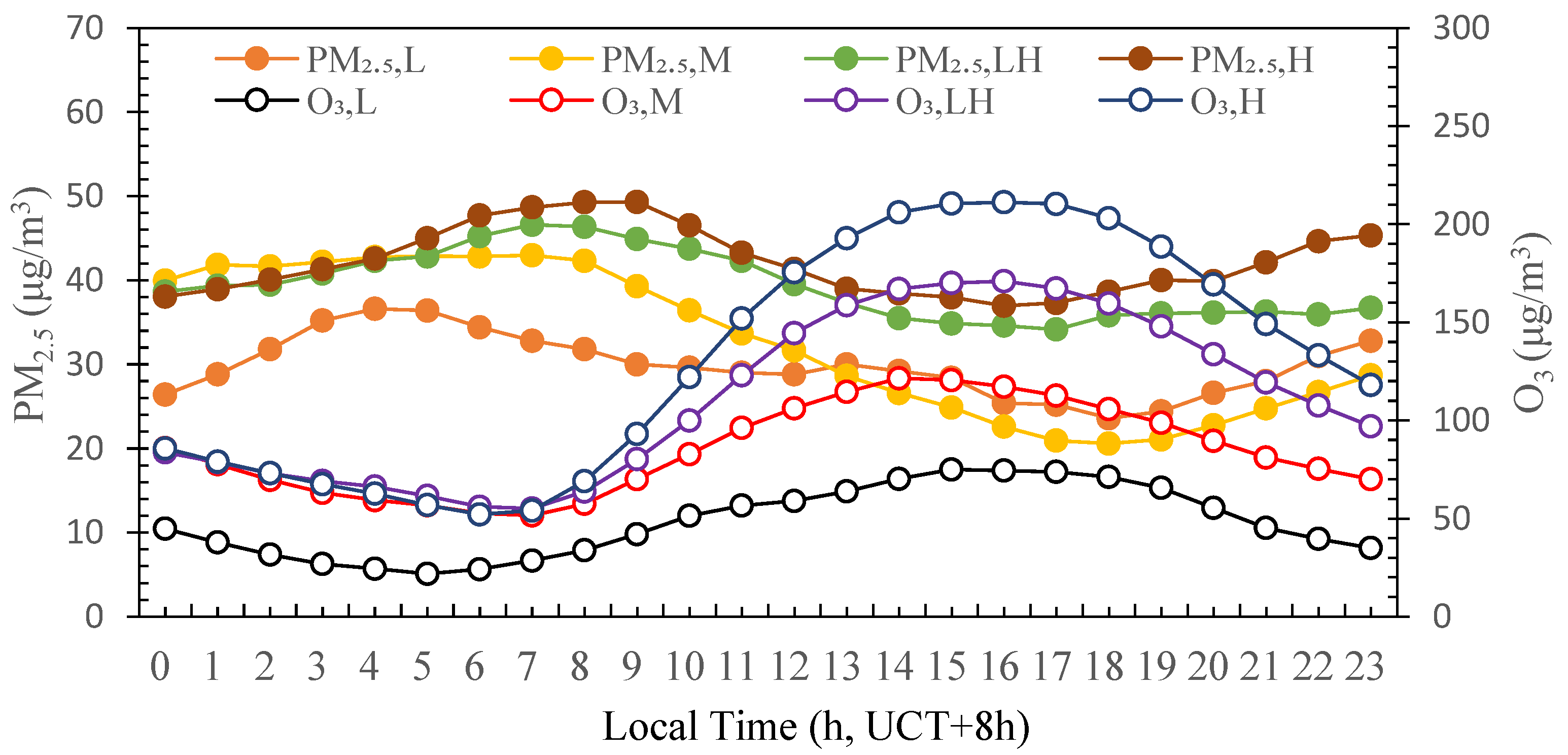

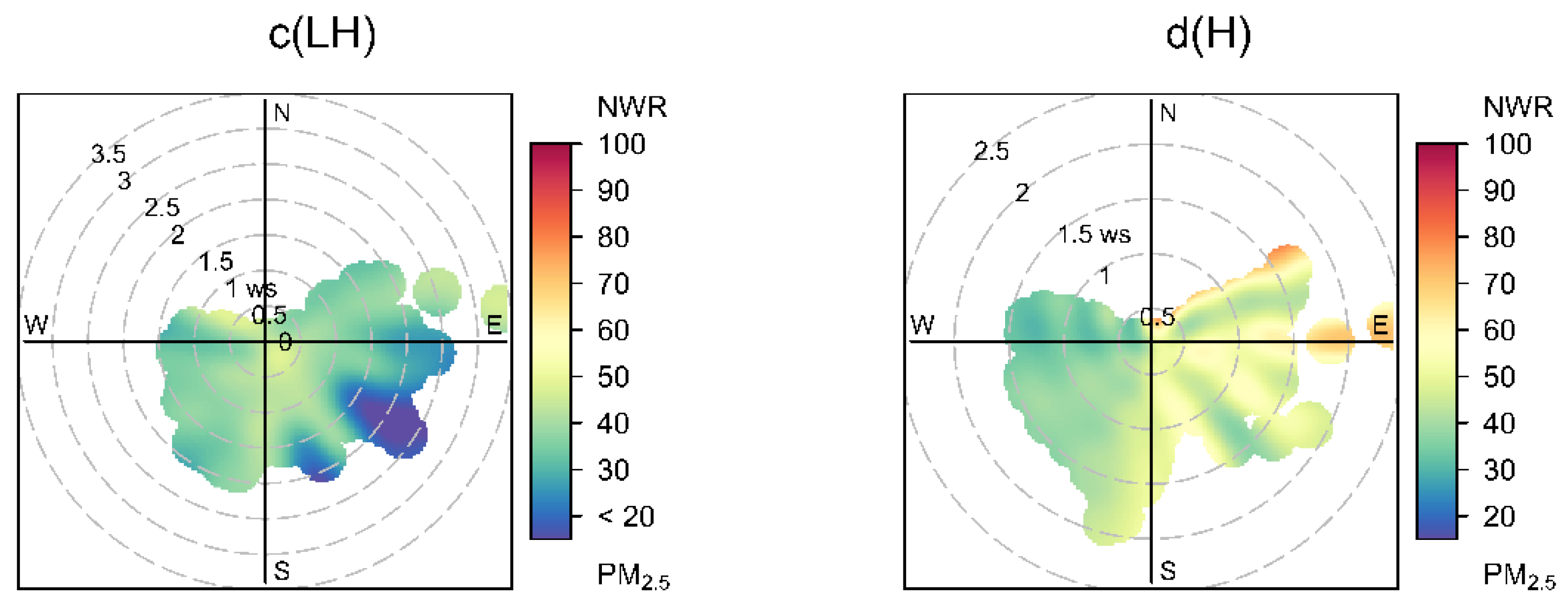


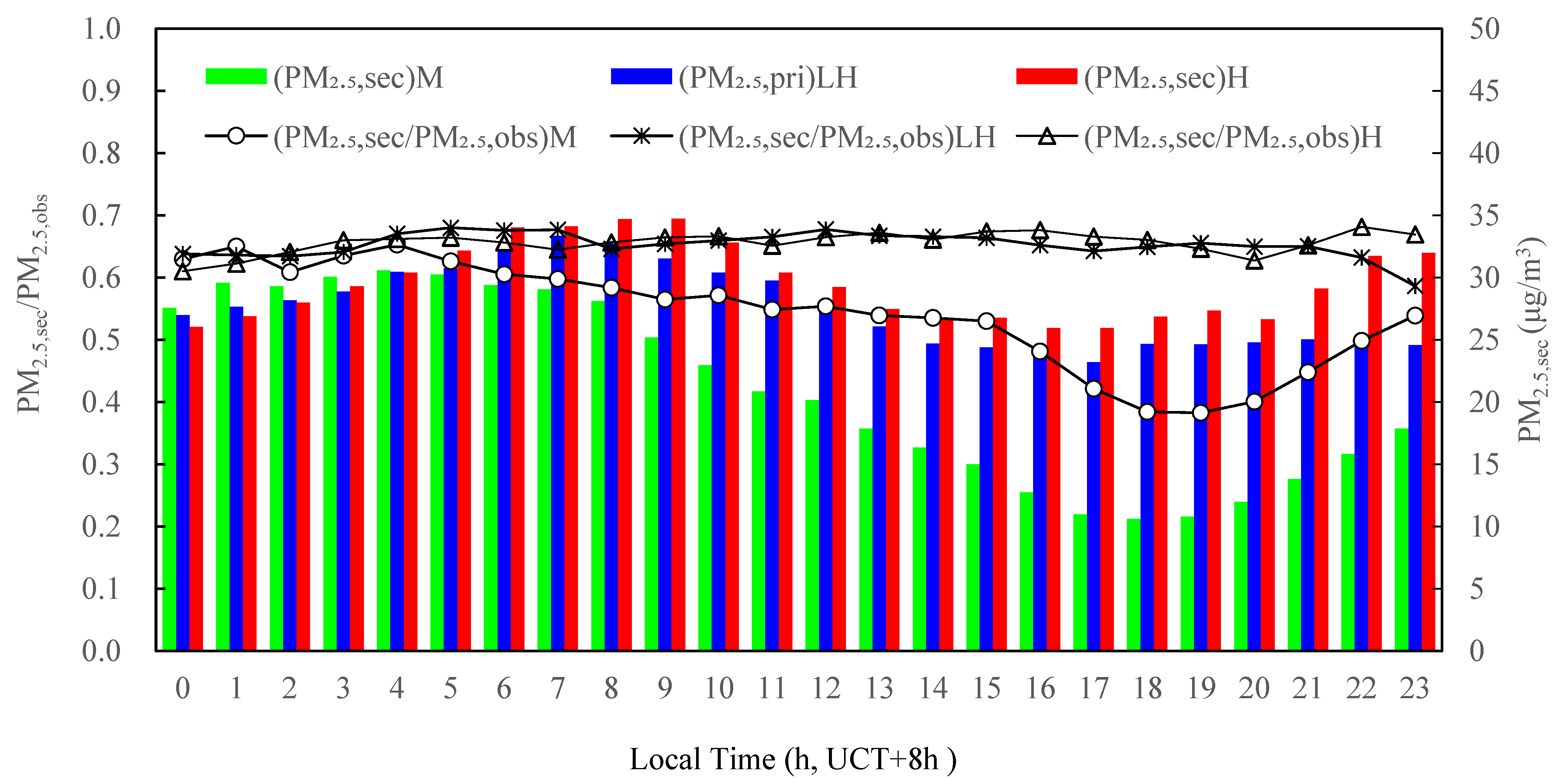

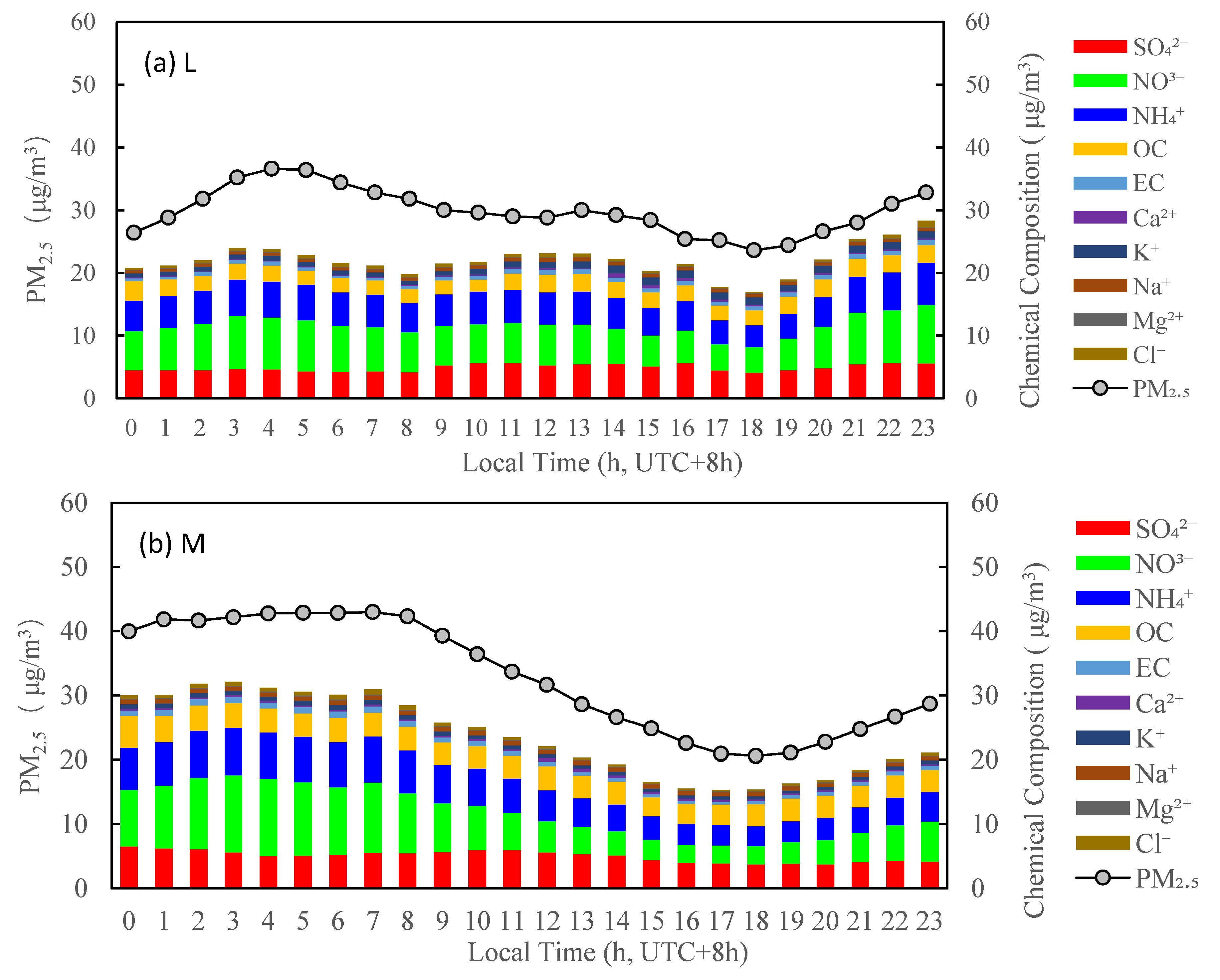
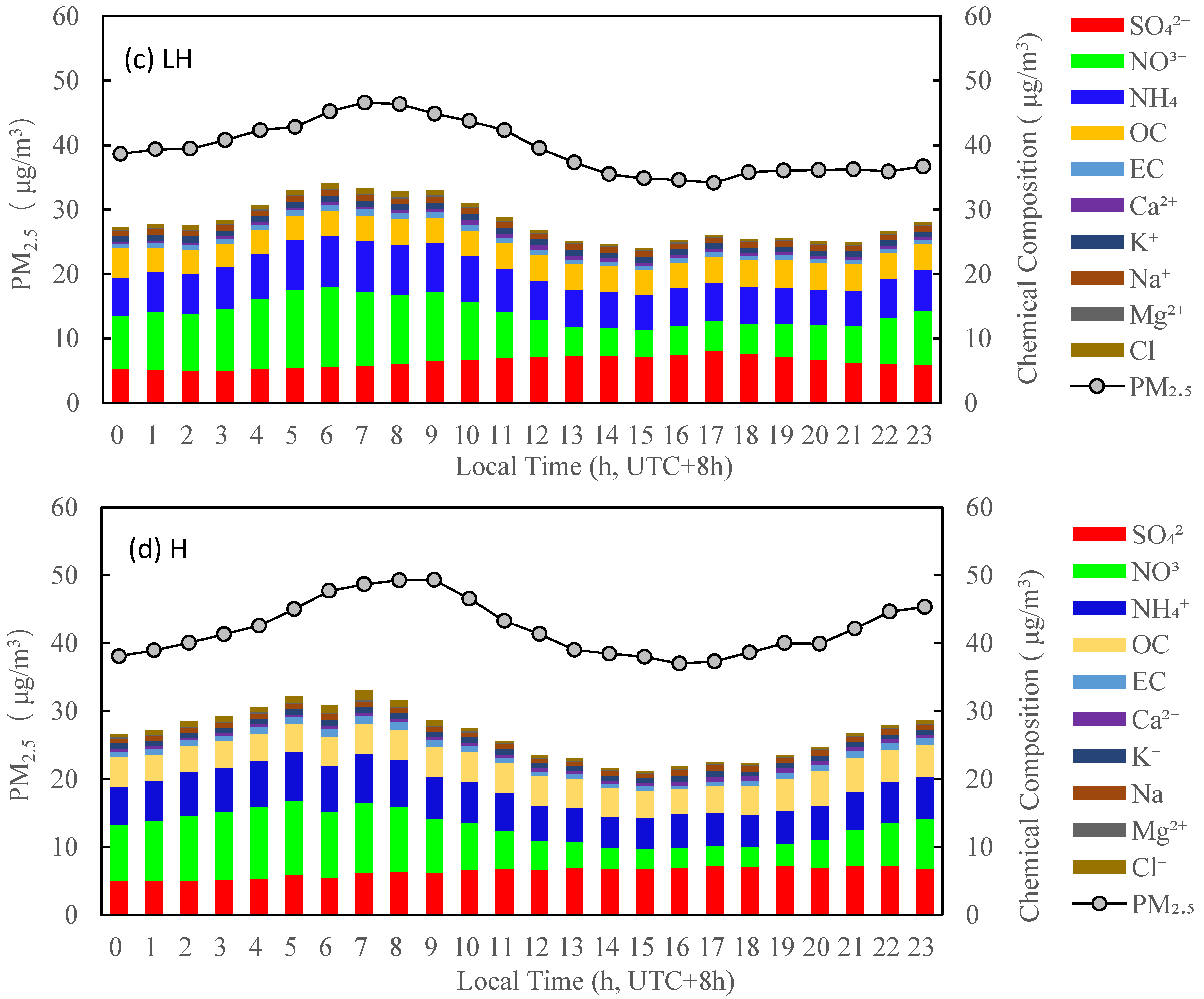

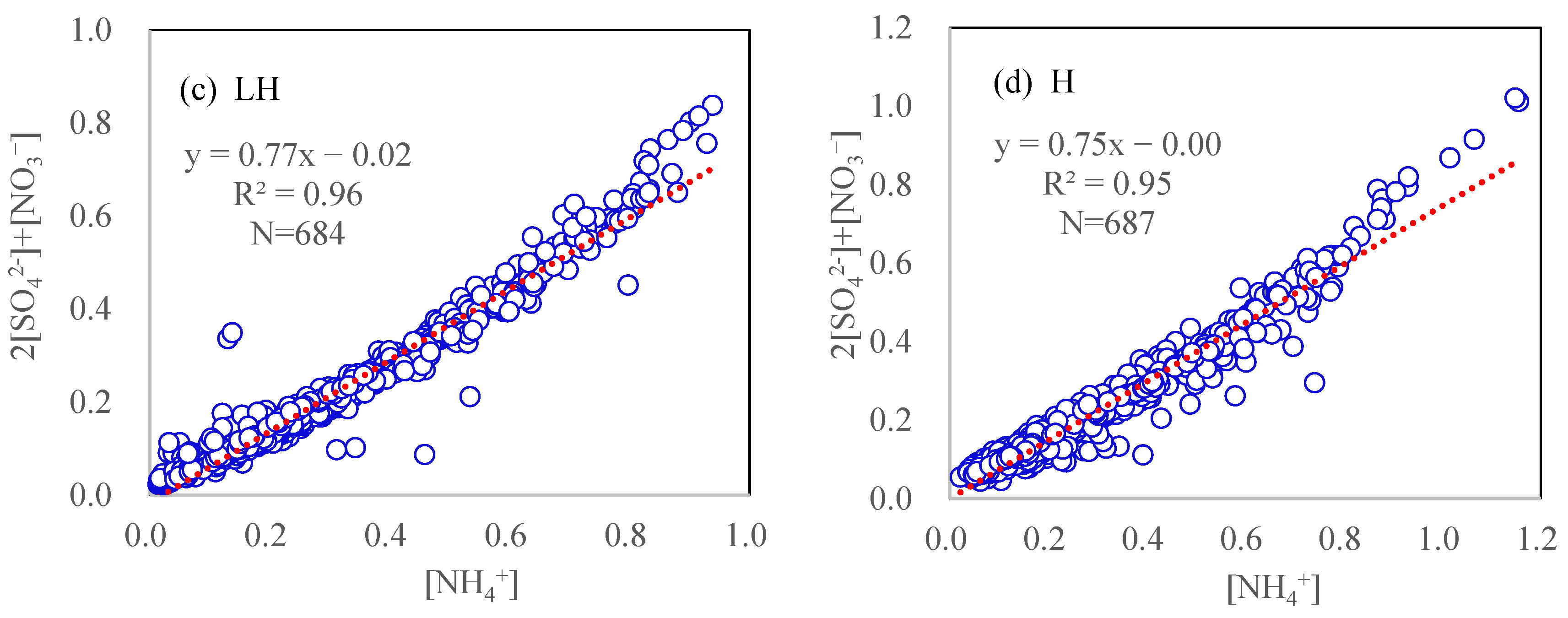
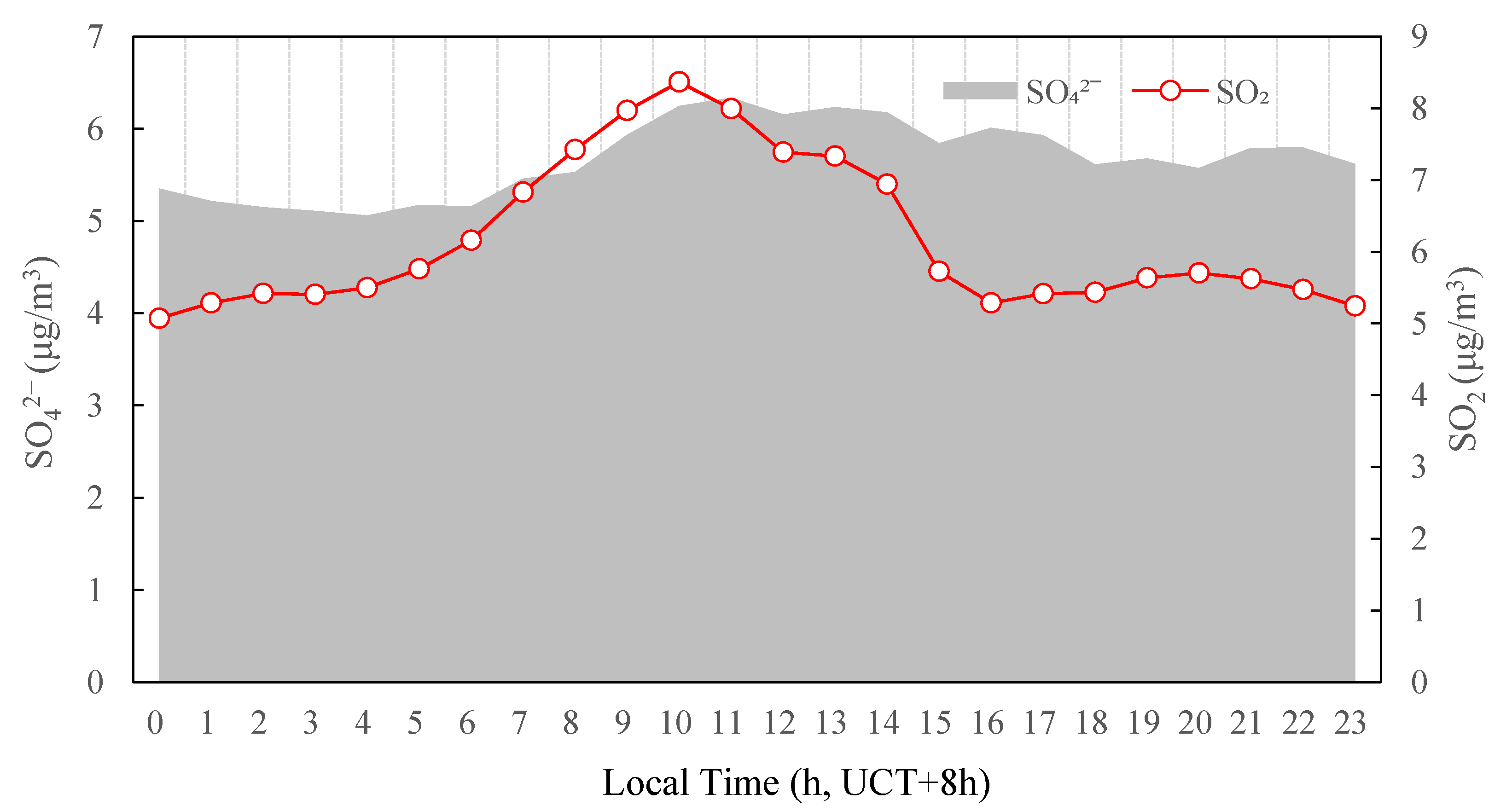
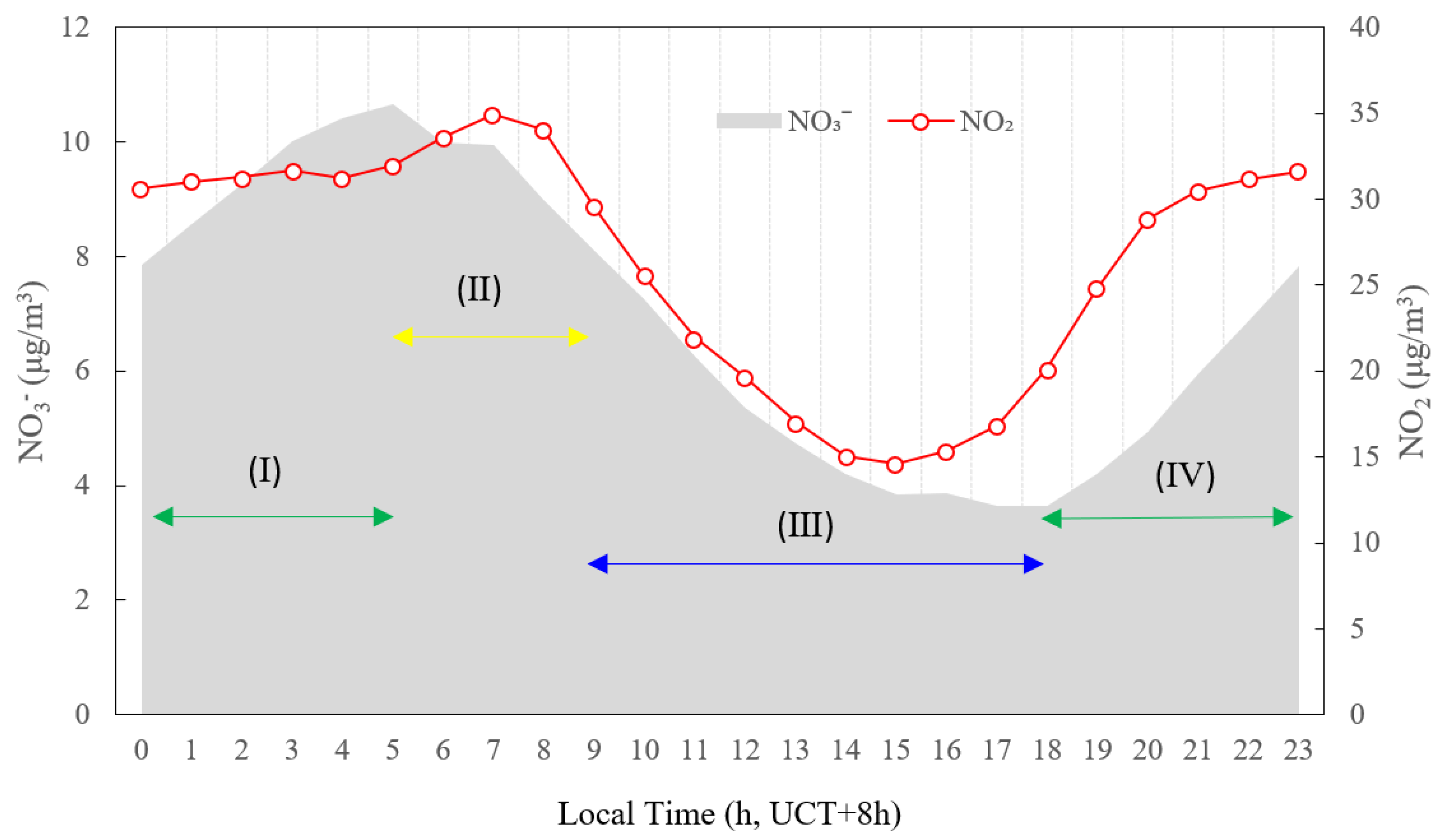
| Levels | OC | EC | Ca²⁺ | K⁺ | NH₄⁺ | Na⁺ | Mg²⁺ | Cl− | NO₃− | SO₄²− | Sum |
|---|---|---|---|---|---|---|---|---|---|---|---|
| L | 2.6 ± 0.8 | 0.7 ± 0.4 | 0.24 ± 0.34 | 0.49 ± 0.80 | 5.09 ± 3.65 | 0.51 ± 0.15 | 0.10 ± 0.07 | 0.44 ± 0.39 | 6.63 ± 5.26 | 4.93 ± 3.29 | 21.4 ± 12.4 |
| M | 3.7 ± 1.7 | 0.7 ± 0.5 | 0.32 ± 0.56 | 0.59 ± 0.48 | 5.26 ± 4.10 | 0.68 ± 0.39 | 0.13 ± 0.07 | 0.44 ± 0.47 | 6.81 ± 7.56 | 5.01 ± 3.35 | 22.5 ± 15.9 |
| LH | 4.0 ± 1.5 | 0.8 ± 0.5 | 0.47 ± 0.55 | 0.89 ± 0.53 | 6.42 ± 3.74 | 0.87 ± 0.39 | 0.18 ± 0.08 | 0.51 ± 0.49 | 7.68 ± 6.90 | 6.40 ± 3.54 | 27.6 ± 14.6 |
| H | 4.3 ± 1.6 | 0.9 ± 0.5 | 0.57 ± 0.57 | 0.77 ± 0.54 | 5.78 ± 3.61 | 0.76 ± 0.58 | 0.17 ± 0.08 | 0.55 ± 0.69 | 6.59 ± 6.29 | 6.36 ± 3.74 | 26.4 ± 13.2 |
Publisher’s Note: MDPI stays neutral with regard to jurisdictional claims in published maps and institutional affiliations. |
© 2022 by the authors. Licensee MDPI, Basel, Switzerland. This article is an open access article distributed under the terms and conditions of the Creative Commons Attribution (CC BY) license (https://creativecommons.org/licenses/by/4.0/).
Share and Cite
Gu, J.; Chen, Z.; Zhang, N.; Peng, S.; Cui, W.; Huo, G.; Chen, F. Characterization of Atmospheric Fine Particles and Secondary Aerosol Estimated under the Different Photochemical Activities in Summertime Tianjin, China. Int. J. Environ. Res. Public Health 2022, 19, 7956. https://doi.org/10.3390/ijerph19137956
Gu J, Chen Z, Zhang N, Peng S, Cui W, Huo G, Chen F. Characterization of Atmospheric Fine Particles and Secondary Aerosol Estimated under the Different Photochemical Activities in Summertime Tianjin, China. International Journal of Environmental Research and Public Health. 2022; 19(13):7956. https://doi.org/10.3390/ijerph19137956
Chicago/Turabian StyleGu, Jinxia, Zexin Chen, Nan Zhang, Shitao Peng, Wenjing Cui, Guangyao Huo, and Feng Chen. 2022. "Characterization of Atmospheric Fine Particles and Secondary Aerosol Estimated under the Different Photochemical Activities in Summertime Tianjin, China" International Journal of Environmental Research and Public Health 19, no. 13: 7956. https://doi.org/10.3390/ijerph19137956





